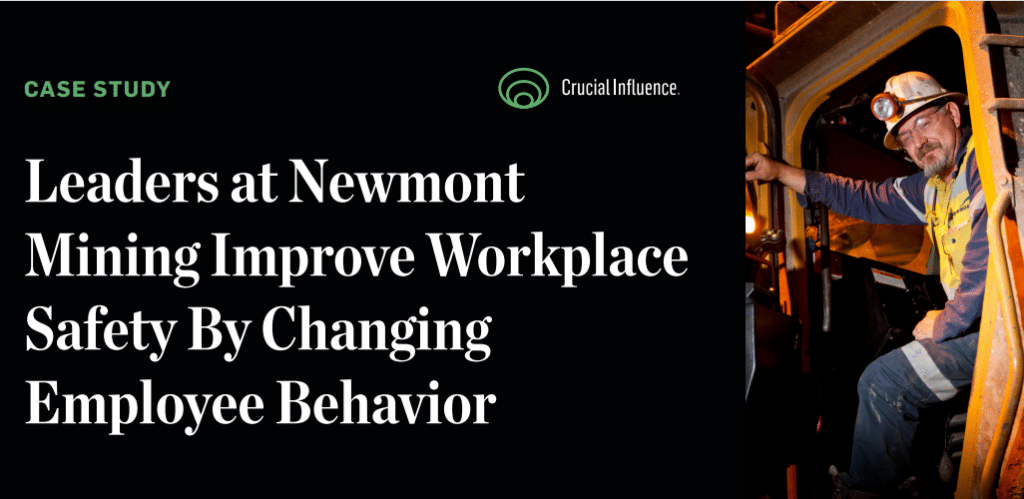One afternoon, I received a call from a company that owned a string of plywood and sawmills up and down the Pacific Northwest in the United States. They asked if we could come interview employees and supervisors to better understand the dynamics of their organisational climate and employee satisfaction in their plywood mills.
This was my very first trip with VitalSmarts, and I thought, “This will be fun! I finally get to talk with real people that do hard work for a living.”
I flew into Sacramento, California, rented a car, and drove to this huge plywood mill nestled in a tiny logging town on the California-Oregon border. The first thing I noticed was the flashing light on an ambulance parked out front. I immediately thought there was some kind of industrial accident.
As I walked in to meet with the plant manager, I said, “I couldn’t help but notice the ambulance outside. I hope nobody was hurt too badly.”
He sighed and said, “One of our supervisors beat up an employee and they have to send him to the hospital. It happens all the time.”
I couldn’t believe it! I’d spent the last several years working with “tame” companies. I’d never heard of such a thing! I suddenly felt like I’d been enlisted by 60 Minutes to do some serious investigative reporting.
The Law of the Hog
After the first several interviews with hourly employees, I realised that no one brought up the supervisor-employee fight that happened earlier in the day, so I decided to ask some leading questions.
When the next worker came in, I asked, “Does it ever happen that an employee doesn’t get along with their boss?”
He looked back at me like I’d just fallen off the turnip wagon. He said, “Well, yeah! What company did you say you worked for?”
So I said, “How bad could it get if an employee and their boss really hated each other?”
To describe his answer, I need to fill you in on how a plywood mill works.
First, they load huge logs onto a lathe which acts like a giant razor to take off thin, wide sheets of veneer. The sheets are then glued together to form plywood. These sheets of veneer aren’t always perfect, though. Sometimes there are knots, uneven logs, and nail holes that make the sheets unusable.
In this particular plant, all of the unusable scrap pieces are taken off the assembly line into a separate room with just one piece of equipment, called the hog.
The hog is a huge machine make of grinders and spinning steel blades that turned scrap wood into sawdust, which was almost worthless.
The employees that ran the hog had some of the most amazing safety equipment you’ve ever seen. In addition to their hard hats and safety glasses, they wore these huge harnesses strapping them to the wall to keep them from getting too close to the hog. This was a dangerous machine.
Back in the interview, when I asked, “What happens if you really hate your boss?”, the worker leaned across the table and said, “The hog!”
He could tell I was terrified.
“No, no, we don’t put our boss in the hog. When our boss leaves our work area, we take perfectly good veneer and throw it into the hog. When someone grinds up good veneer, it hurts the supervisor’s numbers. That gets the supervisor in trouble with the plant manager.”
This was sabotage.
It was from this incident that we created the expression “The Law of the Hog.” It means that if you talk with someone who has disappointed you or behaved poorly, but you do so in a way that is less than professional, others may find a way to get even — i.e., “feed the hog.”
The Hog in our Work Culture
Over the years, we’ve learned that every organisation has its own version of feeding the hog. In one freight-shipping company, employees who become upset at being mistreated have been known to throw perfectly good parts into the deep blue sea. At a computer chip manufacturer, disgruntled associates flush gold chips down the toilet. At a software company, angry code writers purposely write errors into the program.
These acts of sabotage are a means of seeking revenge on the leaders.
Of course, not everyone who believes he or she has been treated poorly seeks such direct and active revenge.
The most common method of feeding the hog takes the form of lost focus, energy, and engagement. After being harshly treated by a leader, employees spend time talking about what just happened rather than doing their job. Next, they refuse to put in the extra effort.
Eventually, they disengage.
A Better Way to Hold Others Accountable
Later that day, I interviewed the supervisor who beat up the employee. He was still extremely frustrated, but I quickly learned there was much more to it than incident earlier in the day.
This was a town of only 3,000 people and virtually everyone worked for the plant. He grew up in the town and his own father had worked at the plant. He’d worked at the mill for years and when he was finally promoted to supervisor, he discovered that it was difficult to get people to listen to him. He desperately wanted employees to follow procedures and meet deadlines, but they often ignored him. With time he learned to rely on intimidation but he hated doing so.
Some of his direct reports were neighbours, others relatives, and now they all saw him as the enemy. His own wife refused to go to church with him or otherwise be seen with him in public.
This was a really sad situation.
He tells me, “You want to know the real problem? I’m motivated. I’m committed to this company’s success, so when one of my employees isn’t committed or motivated, I do whatever it takes to get production out the door. And if that takes beating them up, that’s what I have to do.”
This wasn’t merely a story of aggression followed by revenge.
The supervisor wasn’t evil and the employees weren’t innocent bystanders exacting justice. It was a more complex tale about creating a culture of accountability.
Fortunately, the leadership training we were hired to study actually taught supervisors how to hold others accountable. By learning best practices, the leaders discovered what many skilled leaders had known for years.
When you carefully study how to hold others accountable, and then actually use the skills you’ve learned, you don’t have to rely on intimidation, threats, and abuse. You can deal with deviations and disappointments without feeding the hog.





